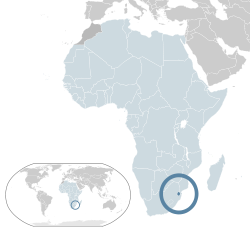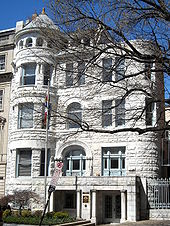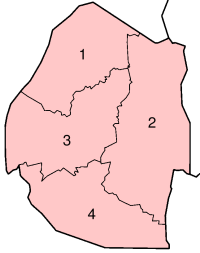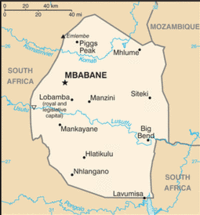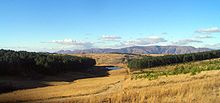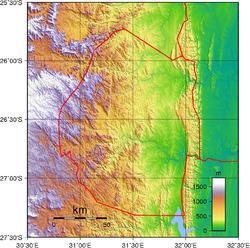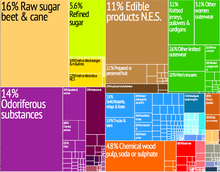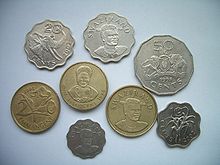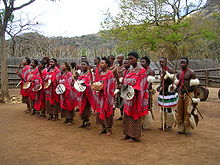
Swaziland
Background Information
SOS Children offer a complete download of this selection for schools for use on schools intranets. Sponsor a child to make a real difference.
| Kingdom of Swaziland Umbuso waseSwatini
|
||||||
|---|---|---|---|---|---|---|
|
||||||
| Motto: "Siyinqaba" ( Swati) "We are a fortress" "We are a mystery/riddle" "We hide ourselves away" |
||||||
| Anthem: Nkulunkulu Mnikati wetibusiso temaSwati Oh God, Bestower of the Blessings of the Swazi |
||||||
|
Location of Swaziland (dark blue)
– in Africa (light blue & dark grey) |
||||||
| Capital | Lobamba (royal / legislative) Mbabane (administrative) 26°19′S 31°8′E |
|||||
| Largest city | Mbabane | |||||
| Official languages |
|
|||||
| Demonym | Swazi | |||||
| Government | Unitary parliamentary absolute constitutional monarchy | |||||
| - | King | King Mswati III | ||||
| - | Ndlovukati | Queen Ntombi | ||||
| - | Prime Minister | Barnabas Sibusiso Dlamini | ||||
| - | Deputy Prime Minister | Themba N. Masuku | ||||
| Legislature | Parliament of Swaziland | |||||
| - | Upper house | Senate | ||||
| - | Lower house | House of Assembly | ||||
| Independence | ||||||
| - | from British mandate | 6 September 1968 | ||||
| Area | ||||||
| - | Total | 17,364 km2 ( 157th) 6,704 sq mi |
||||
| - | Water (%) | 0.9 | ||||
| Population | ||||||
| - | 2009 estimate | 1,185,000 ( 154th) | ||||
| - | 2007 census | 1,018,449 | ||||
| - | Density | 68.2/km2 ( 135th) 176.8/sq mi |
||||
| GDP ( PPP) | 2012 estimate | |||||
| - | Total | $6.242 billion | ||||
| - | Per capita | $5,781 | ||||
| GDP (nominal) | 2012 estimate | |||||
| - | Total | $3.751 billion | ||||
| - | Per capita | $3,474 | ||||
| Gini (2010) | 51.5 high |
|||||
| HDI (2013) | medium · 141st |
|||||
| Currency | South African Rand Swazi Lilangeni ( SZL) |
|||||
| Time zone | SAST ( UTC+2) | |||||
| Drives on the | left | |||||
| Calling code | +268 | |||||
| ISO 3166 code | SZ | |||||
| Internet TLD | .sz | |||||
| Estimates for the country explicitly take into account the effects of excess mortality due to AIDS; this can result in lower life expectancy, higher infant mortality and death rates, lower population and growth rates, and changes in the distribution of population by age and sex than would otherwise be expected. | ||||||
Swaziland, officially the Kingdom of Swaziland ( Swazi: Umbuso weSwatini), and sometimes called Ngwane or Swatini, is a landlocked country in southern Africa, bordered to the north, south and west by South Africa, and to the east by Mozambique. The nation, as well as its people, are named after the 19th-century king Mswati II.
Swaziland is a small country, no more than 200 kilometres (120 mi) north to south and 130 kilometres (81 mi) east to west. The western half is mountainous, descending to a lowveld region to the east. The eastern border with Mozambique and South Africa is dominated by the escarpment of the Lebombo Mountains. The climate is temperate in the west, but may reach 40 °C (104 °F) in summer in the lowveld. Rainfall occurs mainly in the summer and may reach 2 metres (6.6 ft) in the west.
The area that Swaziland now covers has been continuously inhabited since prehistory. Today, the population is primarily ethnic Swazis whose language is Swati, though English is spoken as a second language. The Swazi people descend from the southern Bantu who migrated from central Africa in the 15th and 16th centuries. The Anglo-Boer War saw the United Kingdom make Swaziland a protectorate under its direct control. Swaziland gained independence in 1968. Swaziland is a member of the Southern African Development Community, the African Union, and the Commonwealth of Nations. The head of state is the king, who appoints the prime minister and a small number of representatives for both chambers of parliament. Elections are held every five years to determine the majority of the representatives. A new constitution was adopted in 2005.
Some 75% of the population are employed in subsistence farming, and 60% of the population live on less than the equivalent of US$1.25 per day. Swaziland's main trading partner is South Africa, and its currency is pegged to the South African Rand. Many of Swaziland's peasants make their living by growing marijuana, which is sold to South Africa. Swaziland's economic growth and societal integrity is highly endangered by its disastrous HIV epidemic, to an extent where the United Nations Development Program has written that if it continues unabated, the "longer term existence of Swaziland as a country will be seriously threatened." The infection rate in the country is unprecedented and the highest in the world at 26.1% of adults, and over 50% of adults in their 20s. In the CIA World Factbook, Swaziland is ranked 191st out of 198 countries in life expectancy, with an average life expectancy of only 47.36 years.
History
Artifacts indicating human activity dating back to the early Stone Age 200,000 years ago have been found in the Kingdom of Swaziland. Prehistoric rock art paintings date from ca. 25,000 B.C. and continue up to the 19th century.
The earliest inhabitants of the area were Khoisan hunter-gatherers.They were largely replaced by the Bantu tribes during Bantu migrations who hailed from the Great Lakes regions of eastern Africa. Evidence of agriculture and iron use dates from about the 4th century and people speaking languages ancestral to current Sotho and Nguni languages began settling no later than the 11th century. The Bantu people known as the Swazis established iron-working and settled farming colonies in the 15th century after crossing the Limpopo river. They experienced great economic pressure from the rival Ndwandwe clans from the south.
The country derives its name from a later king, Mswati I. However, Ngwane is an alternative name for Swaziland and Dlamini remains the surname of the royal house, while Nkosi means "king". Scholarly history of Swaziland shows that independent chiefdoms and small kingdoms dominated by various clans were initially conquered and incorporated into the growing Ngwane kingdom ruled by members of the Dlamini clan sometime in the 18th and 19th centuries, long before British colonisation.
According to Swazi royalist tradition, these clans came to be classified in the Dlamini kingdom as the Emakhandzambile category of clans ("those found ahead", e.g. the Gamedze), meaning that they were on the land prior to Dlamini immigration and conquest, as opposed to the Bomdzabuko ("true Swazi") who accompanied the Dlamini kings, and the Emafikemuva ("those who came behind") who joined the kingdom later. Emakhandzambile clans initially were incorporated with wide autonomy, and often in part by granting them special ritual and political status ( cf. mediatisation), but the extent of their autonomy was drastically curtailed by King Mswati II, who attacked and subdued some of the clans in the 1850s.
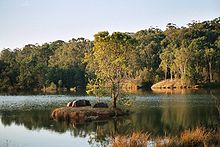
The autonomy of the Swaziland Nation was influenced by British rule of southern Africa in the 19th and early 20th centuries. In 1881 the British government signed a convention recognising Swazi independence. However, controversial land and mineral rights concessions were made under the authority of the Foreign Jurisdiction Act of 1890 in terms of which the administration of Swaziland was also placed under that of the then South African Republic (Transvaal). Swaziland was indirectly involved in the Second Boer War (1899–1902). In 1902 Swaziland became a British Protectorate, with much of its administration (for example, postal services) being carried out from South Africa (SA postage stamps were used in Swaziland until 1933).
The Swaziland independence Constitution was promulgated by Britain in November 1963 in terms of which a legislative Council and an Executive Council were established. This development was opposed by the Swazi National Council (liqoqo).
Despite such opposition, elections took place and the first Legislative Council of Swaziland was constituted on 9 September 1964. Changes to the original constitution proposed by the Legislative Council were accepted by Britain and a new Constitution providing for a House of Assembly and Senate was drawn up. Elections under this Constitution were held in 1967. Swaziland was briefly a Protected State until Britain granted it full independence in 1968.
According to the US State Department, "Swaziland is a member of the Southern African Customs Union (SACU), with which the U.S. began negotiating a free trade agreement in May 2003." This free trade agreement meant changes to SACU's formula, and as a result whereas "SACU receipts contribute more than half of the country's national revenue", however "due to changes in the revenue formula, Swaziland's share has dropped from 741 million dollars to 281 million dollars." As a result, in June 2011, Swaziland, fearing bankruptcy, asked for a financial bailout from South Africa.
Government
The head of state is the king or Ngwenyama (lit. Lion), currently King Mswati III, who ascended to the throne in 1986 after the death of his father King Sobhuza II in 1982 and a period of regency. By tradition, the king reigns along with his mother or a ritual substitute, the Ndlovukati (lit. She-Elephant). The former was viewed as the administrative head of state and the latter as a spiritual and national head of state, with real power counterbalancing that of the king, but during the long reign of Sobhuza II the role of the Ndlovukati became more symbolic. The king appoints the prime minister from the legislature and also appoints a minority of legislators to both chambers of Libandla (parliament), with help from an advisory council. The king is allowed by the constitution to appoint some members to parliament for special interests. These special interests are citizens who might have been left out by the electorate during the course of elections or did not enter as candidates. This is done to balance views in parliament. Special interests could be people of gender, race, disability, business community, civic society, scholars, chiefs and so on. The Senate consists of 30 members, of which some are appointed by the king on recommendation of the advisory council and others elected by the lower house. The House of Assembly has 65 seats, 55 of which are occupied by elected representatives from the 55 constituencies around the country, 10 appointed by the king on recommendation of the advisory council and the attorney general is the ex-officio member. Elections are held every five years.
In 1968, Swaziland adopted a Westminster-style constitution, but in 1973 King Sobhuza II on the advice of parliament at the time suspended it due to widespread complaints by citizens of the country. In 2001, King Mswati III appointed a committee to draft a new constitution. Drafts were released for comment in May 1999 and November 2000. These were strongly criticised by civil society organisations in Swaziland and human rights organisations elsewhere. In 2005, the constitution was put into effect, though there is still much debate in the country about the constitutional reforms. From the early seventies, there was active resistance to the royal hegemony. However despite complaints from progressive formations, support for the monarchy and the current political system remains strong in a majority of the population. Submissions were made by citizens around the country to commissions including the constitutional draft committee that they would prefer to maintain the current situation.
The Swazi bicameral Parliament or Libandla consists of the Senate (30 seats; 10 members appointed by the House of Assembly and 20 appointed by the monarch; to serve five-year terms) and the House of Assembly (65 seats; 10 members appointed by the monarch and 55 elected by popular vote; to serve five-year terms) elections: House of Assembly – last held 19 September 2008 (next to be held in 2013) election results: House of Assembly – balloting is done on a non-party basis; candidates for election are nominated by the local council of each constituency and for each constituency the three candidates with the most votes in the first round of voting are narrowed to a single winner by a second round.
Administrative divisions
Swaziland is divided into four districts:
- Hhohho
- Lubombo
- Manzini
- Shiselweni
Each district is further divided into tinkhundla. There are 55 tinkhundla in Swaziland and each elects one representative to the House of Assembly of Swaziland.
Geography
Swaziland lies across a geological fault which runs from the Drakensberg Mountains of Lesotho, north through the Eastern highlands of Zimbabwe, forms the Great Rift Valley of Kenya and, eventually, peters out in present-day Turkey.
A small, land-locked Kingdom, Swaziland is bordered in the North, West and South by the Republic of South Africa and by Mozambique in the East. Although Swaziland has a land area of only 17,364 km2, roughly the size of Wales or the American State of New Jersey, it contains four separate geographical regions. These run from North to South and are determined by altitude.
Swaziland is located at approximately 26°30'S, 31°30'E. Swaziland also offers a wide variety of landscapes, from the mountains along the Mozambican border to savannas in the east and rain forest in the northwest. Several rivers flow through the country, such as the Great Usutu River.
Along the eastern border with Mozambique is the Lubombo, a mountain ridge, at an altitude of around 600 meters. The mountains are broken by the canyons of three rivers, the Ngwavuma, the Usutu and the Mbuluzi River. This is cattle ranching country.
The western border of the country, with an average altitude of 1200 meters, lies on the edge of an escarpment. Between the mountains rivers rush through deep gorges making this a most scenic region. Mbabane, the capital, is located on the Highveld.
The Middleveld, lying at an average 700 meters above sea level is the most densely populated region of Swaziland with a lower rainfall than the mountains. Manzini, the principal commercial and industrial city, is situated in the Middleveld.
The Lowveld of Swaziland, at around 250 meters, is less populated than other areas and presents a typical African bush country of thorn trees and grasslands. Development of the region was inhibited, in early days, by the scourge of malaria.
Climate
The seasons are the reverse of those in the Northern Hemisphere with December being mid-summer and June mid-winter. Generally speaking, rain falls mostly during the summer months, often in the form of thunderstorms. Winter is the dry season. Annual rainfall is highest on the Highveld in the West, between 1,000 and 2,000 mm (39.4 and 78.7 in) depending on the year. The further East, the less rain, with the Lowveld recording 500 to 900 mm (19.7 to 35.4 in) per annum. Variations in temperature are also related to the altitude of the different regions. The Highveld temperature is temperate and, seldom, uncomfortably hot while the Lowveld may record temperatures around 40 °C (104 °F) in summer.
The average temperatures at Mbabane, according to seasons:
| Spring | September – October | 18 °C (64.4 °F) |
| Summer | November – March | 20 °C (68 °F) |
| Autumn | April – May | 17 °C (62.6 °F) |
| Winter | June – August | 13 °C (55.4 °F) |
Economy
Swaziland's economy is diversified, with agriculture, forestry and mining accounting for about 13% of GDP, manufacturing (textiles and sugar-related processing) representing 37% of GDP and services – with government services in the lead – constituting 50% of GDP. Title Deed Lands (TDLs), where the bulk of high value crops are grown (sugar, forestry, and citrus) are characterised by high levels of investment and irrigation, and high productivity. Nevertheless, the majority of the population – about 75%—is employed in subsistence agriculture on Swazi Nation Land (SNL), which, in contrast, suffers from low productivity and investment. This dual nature of the Swazi economy, with high productivity in textile manufacturing and in the industrialised agricultural TDLs on the one hand, and declining productivity subsistence agriculture (on SNL) on the other, may well explain the country's overall low growth, high inequality and unemployment.
Economic growth in Swaziland has lagged behind that of its neighbours. Real GDP growth since 2001 has averaged 2.8%, nearly 2 percentage points lower than growth in other Southern African Customs Union (SACU) member countries. Low agricultural productivity in the SNLs, repeated droughts, the devastating effect of HIV/AIDS and an overly large and inefficient government sector are likely contributing factors. Swaziland's public finances deteriorated in the late 1990s following sizeable surpluses a decade earlier. A combination of declining revenues and increased spending led to significant budget deficits.
The considerable spending did not lead to more growth and did not benefit the poor. Much of the increased spending has gone to current expenditures related to wages, transfers, and subsidies. The wage bill today constitutes over 15% of GDP and 55% of total public spending; these are some of the highest levels on the African continent. The recent rapid growth in SACU revenues has, however, reversed the fiscal situation, and a sizeable surplus was recorded since 2006. SACU revenues today account for over 60% of total government revenues. On the positive side, the external debt burden has declined markedly over the last 20 years, and domestic debt is almost negligible; external debt as a percent of GDP was less than 20% in 2006.
The Swazi economy is very closely linked to the South African economy, from which it receives over 90% of its imports and to which it sends about 70% of its exports. Swaziland's other key trading partners are the United States and the EU, from whom the country has received trade preferences for apparel exports (under the African Growth and Opportunity Act – AGOA – to the US) and for sugar (to the EU). Under these agreements, both apparel and sugar exports did well, with rapid growth and a strong inflow of foreign direct investment. Textile exports grew by over 200% between 2000 and 2005 and sugar exports increasing by more than 50% over the same period.
The continued vibrancy of the export sector is threatened by the removal of trade preferences for textiles, the accession to similar preferences for East Asian countries, and the phasing out of preferential prices for sugar to the EU market. Swaziland will thus have to face the challenge of remaining competitive in a changing global environment. A crucial factor in addressing this challenge is the investment climate. The recently concluded Investment Climate Assessment provides some positive findings in this regard, namely that Swaziland firms are among the most productive in Sub-Saharan Africa, although they are less productive than firms in the most productive middle-income countries in other regions. They compare more favourably with firms from lower middle income countries, but are hampered by inadequate governance arrangements and infrastructure.
Swaziland's currency is pegged to the South African Rand, subsuming Swaziland's monetary policy to South Africa. Customs duties from the Southern African Customs Union, which may equal as much as 70% of government revenue this year, and worker remittances from South Africa substantially supplement domestically earned income. Swaziland is not poor enough to merit an IMF program; however, the country is struggling to reduce the size of the civil service and control costs at public enterprises. The government is trying to improve the atmosphere for foreign direct investment.
Demographics
The majority of Swaziland's population is ethnically Swazi, mixed with a small number of Zulu and White Africans, mostly people of British and Afrikaner descent. Traditionally Swazi have been subsistence farmers and herders, but most now mix such activities with work in the growing urban formal economy and in government. Some Swazi work in the mines in South Africa.
Swaziland also received Portuguese settlers and African refugees from Mozambique. Christianity in Swaziland is sometimes mixed with traditional beliefs and practices. Many traditionalists believe that most Swazi ascribe a special spiritual role to the monarch. Residents of Swaziland have the lowest documented life expectancy in the world at 31.88 years, less than half the world average of 69.4.
Languages
SiSwati (also known as Swati, Swazi or Siswati) is a Bantu language of the Nguni Group, spoken in Swaziland and South Africa. It has 2.5 million speakers and is taught in schools. It is an official language of Swaziland (along with English) and one of the official languages of South Africa.
About 76,000 people in the country speak Zulu. Tsonga, which is spoken by many people throughout the region is spoken by about 19,000 people in Swaziland. Afrikaans is also spoken by some residents of Afrikaner descent.
Religions
82.70% of the total population adheres to Christianity, making it the most common religion in Swaziland. Various Protestant and indigenous African churches, including African Zionist, constitute the majority of the Christians (40%), followed by Roman Catholicism at 20% of the population. There are also smaller numbers non-Christian religions practised in the country such as Islam (0.95%), the Bahá'í Faith (0.5%), and Hinduism (0.15%). There are 14 Jewish families.



